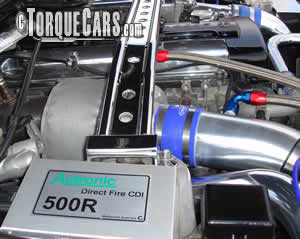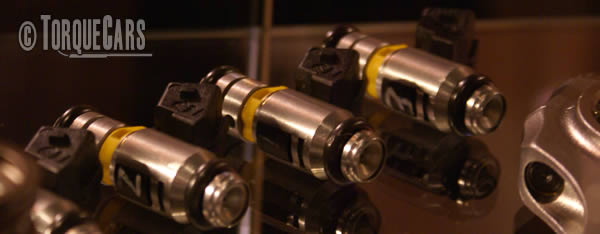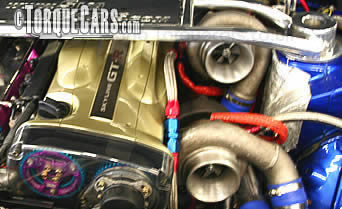Turbo upgrades with aftermarket turbos
"Gimme a boost"

Turbochargers make a massive difference to an engine and there are many upgrade options to choose from so we'll examine your options here.
Big turbos make more power but this increases the wear an tear on the engine and heat becomes a big problem.
The turbo charger in a petrol engine can reach 1100 degrees and will spin at speeds of 100,000 to 150,000rpm.
On some setups and new models of turbo you can double those speeds. These speeds require lubrication, heat management and perfect balance. The biggest risk to a turbo is a failed oil seal, blocked oil feed or a worn bearing.
To upgrade your turbo you have 2 paths.
- Fit a hybrid turbo (based on your OEM casing but with internals from another turbo or with a different design)
- Fit an uprated turbo, these tend to be larger, and will usually require additional pipework and effort to get them to fit.
The first option pretty much just bolts on where the original was removed, but you will need to tune/remap to get the full benefit although most hybrid turbos will just about run ok on standard maps at lower boost levels.
Please watch our video which explains turbos and all you need to know about them. Be sure to keep up with our latest YouTube content and subscribe.
Attention is given to the air intake aperture shape and compressor wheel and turbine profile.

These can spin faster, compress more air or give boost at high or low RPM figures so you have a to choose the options to match your requirements.
Track day cars work best at high RPM and high boost levels with large turbos, road cars need low down power so generally a smaller turbo offers a flatter torque curve without much lag.
A hybrid turbo will also have stronger bearings (ball bearings), be better balanced and have stronger seals. This enhances reliability and boost from lower RPM levels.
Path 2 involves a more dramatic turbo design most people taking this route opt for large turbos which can be laggy low down but will almost double an engines power output.
All aspects of the turbo are rebuilt and often additional oil pipes and cooling pipes are included.
Aftermarket Turbos are often cannibalized with the optimum parts formed into a hybrid unit.
Conversion to twin charging (supercharger and turbo), twin turbos and single large turbo replacements all count as turbo upgrades with each giving totally different boost characteristics.
For best results the ECU (engine control unit) should be tuned/remapped so the characteristics of the turbo can be taken into account and maximum power can be extracted.
More air in the engine will also require more fuel and depending on how much extra power you are wanting to extract you will also need to uprate the injectors and the fuel pump.

TorqueCars recommend you consult a specialist tuner outlining your exact requirements so they can source a suitable turbo profile and map for you.
Here are some of the options and goals you will need to think about.
Generally you need to choose the power curve (do you want a large peak power figure on a narrow rpm band or are you looking for a wide torque band across the rev range.
Are you after less lag low down and more instantaneous power (ideal for a road car) -but this will be at the cost of a slightly lower peak power?
Alternatively a high headline power figure will usually mean a larger amount of lag at lower revs as the turbo spools up.

A large turbo will tend to give a big amount of lag at low revs but provide a massive power hike at high revs.
A twin turbo setup and good quality boost controller can minimize the amount of lag at low revs and give a good power gain throughout the rev range.
It it also possible to have a small turbo and large turbo set up with a controller to use the small turbo at low revs and kick in the larger one as the revs increase.
Quad turbo installations are also being introduced by tuning houses along with standard OEM cars that run a supercharger and turbo simultaneously.
We are also seeing various types of high-tech components such as variable geometry turbines, ceramics fins and ceramic bearings and ceramic coatings on or in the turbo housing as well as cryogenically treated turbo components. It is certainly an exciting time in the world of forced induction.
There are also twin scroll turbos which are relatively new but offer many benefits, but are not suitable for 3 or 5 cylinder engines.
Most types of turbo engine including diesel turbos can be upgraded in this way and you can double the power - but this is rarely safe on standard internals forged components and balancing the engine will help with reliability.
(NB: Turbo diesel engines run cooler that petrol counterparts so the turbos tend to be larger and therefore have more scope for modification as an OEM spec unit.)
Diesel engine turbochargers run at lower exhaust flow rates so tend to be physically smaller than a petrol engine.
Stage 1 upgrades are usually hybrids that bolt straight on. Stages 2-3 will nearly always require fuelling upgrades and other modifications.
For more info on tuning stages, click here.
Most turbo engines can cope on standard internals with a power hike of 30% - you could even push the power levels up in the lower RPM without moving the peak power figure and retain an engines reliability.
As with all modifications the higher the power gain the lower the reliability of the engine and the greater the maintenance costs.
Uprate the fuelling and may well need a custom boost controller and BOV.
Whatever option you go for we strongly recommend an upgrade to a ball bearing based turbo unit as these spool up much faster, can tolerate higher speeds and hotter temperatures and are generally more reliable than the thrust bearing types of turbo.
Further reading - in depth articles about turbos.
- Intro to turbos
- Turbos vs superchargers
- Fitting Turbo to a NA (naturally aspirated) engine
- Turbo upgrades
- Hybrid Turbos
- Twin Scroll Turbos
- Boost Controllers
If you want to learn more about turbo applications for your car please join our friendly car forums where you can chat with like minded car enthusiasts and talk technical.
Please Check out my YouTube channel, we're regularly adding new content...
PLEASE HELP: I NEED YOUR DONATIONS TO COVER THE COSTS OF RUNNING THIS SITE AND KEEP IT RUNNING. I do not charge you to access this website and it saves most TorqueCars readers $100's each year - but we are NON PROFIT and not even covering our costs. To keep us running PLEASE Donate here
If you liked this page please share it with your friends, drop a link to it in your favourite forum or use the bookmarking options to save it to your social media profile.
Feedback - What do You Think?
Please use our forums if you wish to ask a tuning question, and please note we do not sell parts or services, we are just an online magazine.
Help us improve, leave a suggestion or tip
Please watch this video and subscribe to my YouTube channel.
2 Responses to “Turbo tuning stage 1-3: Aftermarket OEM turbos upgrade kit.”

 Click to accept YouTube Cookies & Play.
Click to accept YouTube Cookies & Play.
If you want to retain the stock turbo you can have the cold side compressor housing high flowed which involves machining the housing to fit a larger diameter comp wheel fir a worthwhile power gain.
Hi im looking to achive around 180-200BHP on my Polo tsi 1.2 2015. was thinking of going hybrid turbo what do i need to buy?